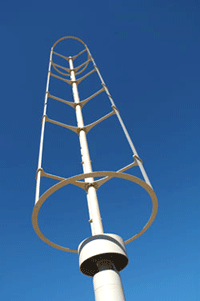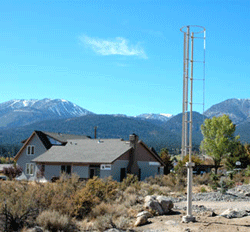Sleek and Cheap
Air Date: Week of April 4, 2008

The eggbeater design of the vertical axis wind turbine is nothing new but it may be the wave of the future. A small company in Nevada is testing the efficiency of their vertical turbines and, as Spectrum Radio's Prachi Patel-Predd reports, if they pass muster, the relatively inexpensive windmills may soon be on the market for homeowners.
Transcript
GELLERMAN: The wind power industry is picking up energy in the United States. Last year, we installed enough wind generators to power one and a half million American homes. Most of that comes from large wind farms. Less than one percent is generated by small wind turbines that you can find in backyards, farms -- even on the roofs of buildings. The problem with small wind generators is that they cost big money. But now, a Nevada company has come out with a cheaper, more efficient model that updates an old design. Spectrum Radio’s Prachi Patel-Predd has our story.
[WIND TURBINE WHIRRING]
PATEL-PREDD: On a field in Spanish Fork, Utah, about 50 miles south of Salt Lake City, a wind turbine spins furiously. If you’re picturing something that looks like a propeller, think again. This silver turbine looks more like a tall and slender egg-beater. It has three long, vertical blades that spin around a shaft. It’s 30 feet tall and four feet wide.
[WIND TURBINE WHIRRING]
PATEL-PREDD: The concept isn’t new. Vertical axis turbines have been around since the late nineteen-twenties. But they never took off like the popular three-blade propeller-type turbines because they weren’t very efficient. Now, they’re making a comeback because of better materials and designs...and a push for clean energy. Trudy Forsythe is a researcher with the Department of Energy’s National Wind Technology Center.
FORSYTHE: As the U.S. market expands because of incentive programs that exist in states or in different utility sectors more and more people are interested in designing the turbine of the future, many of them are convinced that a vertical axis turbine is the answer to that.

(Courtesy of Mariah Power)
HESS: With a 20-year life, it gives you an average cost of electricity of about 12.4 cents per kilowatt-hour, which is the same as the average cost of power from utilities across the United States today.
PATEL PREDD: That price is for average wind speeds of 12 miles per hour. Many other small turbines can compete with utility prices. But Mariah’s is the first vertical axis design that is competitive with utilities. In fact, the last American company that tried to sell electricity from vertical axis turbines went bankrupt in 1997. So Hess is taking a gamble, one that he thinks might pay off.
HESS: We have about 2,000 units that have already been reserved by people and ordered, so to speak.
PATEL PREDD: Hess believes vertical-axis designs are better for backyards than horizontal-axis trubines. He says they’re quieter, don’t take up much space, and are safer for bats and birds because they work at lower speeds. These pluses have been overshadowed in the past for several reasons, says energy consultant Mick Sagrillo.

Courtesy of Mariah Power
PATEL PREDD: These are the reasons why most turbine makers are pursuing traditional propeller type designs. But newer materials and designs have addressed past problems. Turbine blades are typically made of steel and aluminum alloys, which add weight. Mariah used light and strong aircraft-grade aluminum. And they've spent three years tweaking their design to get one that captures as much energy from wind as possible. First, they designed a generator that is 98 percent efficient. Then they developed a turbine shape that drives a generator, even at low wind speeds. Field tests in Utah and at the National Wind Technology Center will tell whether the technology works as well as Mariah claims it does. Mick Sagrillo says Mariah is the only vertical axis turbine manufacturer doing such testing. For now, their tests have won him over.
SAGRILLO: They are going through the effort and the expense and the time that’s involved in actually taking a look at the turbine, having an independent evaluator in an engineering firm help them with the development and doing the testing. And for that reason alone, I think they’re worth consideration.
PATEL PREDD: Mariah is expecting final results from the Utah tests any time now. If all goes well, the turbine might be ready to go up in your backyard before this summer. For Living on Earth, I’m Prachi Patel-Predd.
GELLERMAN: Our story on vertical wind turbines comes to us courtesy of Spectrum Radio, the broadcast edition of IEEE Spectrum, the magazine of technology insiders.
Links
Living on Earth wants to hear from you!
Living on Earth
62 Calef Highway, Suite 212
Lee, NH 03861
Telephone: 617-287-4121
E-mail: comments@loe.org
Newsletter [Click here]
Donate to Living on Earth!
Living on Earth is an independent media program and relies entirely on contributions from listeners and institutions supporting public service. Please donate now to preserve an independent environmental voice.
NewsletterLiving on Earth offers a weekly delivery of the show's rundown to your mailbox. Sign up for our newsletter today!
 Sailors For The Sea: Be the change you want to sea.
Sailors For The Sea: Be the change you want to sea.
 The Grantham Foundation for the Protection of the Environment: Committed to protecting and improving the health of the global environment.
The Grantham Foundation for the Protection of the Environment: Committed to protecting and improving the health of the global environment.
 Contribute to Living on Earth and receive, as our gift to you, an archival print of one of Mark Seth Lender's extraordinary wildlife photographs. Follow the link to see Mark's current collection of photographs.
Contribute to Living on Earth and receive, as our gift to you, an archival print of one of Mark Seth Lender's extraordinary wildlife photographs. Follow the link to see Mark's current collection of photographs.
 Buy a signed copy of Mark Seth Lender's book Smeagull the Seagull & support Living on Earth
Buy a signed copy of Mark Seth Lender's book Smeagull the Seagull & support Living on Earth

